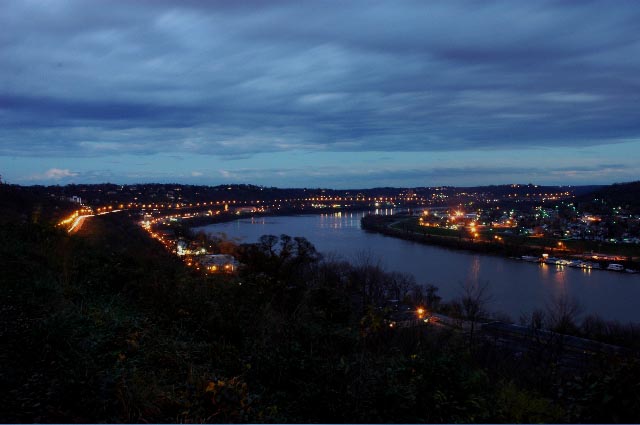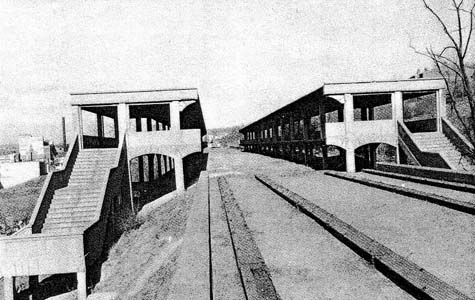
The eastern half of the line would have paralleled the river uphill from Columbia Parkway,
providing one of the most dramatic views from any transit line in the United States.
[Jake Mecklenborg November 2004]

The demise of Cincinnati's subway is one of the
biggest
missed opportunities in the city's history. While the subway and
Rapid Transit Loop would likely have done little to boost population,
there
is no doubt it would have affected city physically and culturally in
numerous
positive ways. We can be certain that the route of I-75, I-71,
and the Norwood Lateral could not have been built as they exist today,
since they all occupy land that was graded or was planned to be
utilized by the transit loop. Under Schme IV, land where Ft.
Washington Way and the 3rd St. Viaduct now stand was planned for a
viaduct connecting the subway's portal at 3rd & Walnut and Mt.
Adams.
Also, with the underground passage built at the Race
St. station,
and the elaborate passages planned for the never-built Fountain Square
station, it is possible that the the city would have developed a
network
of underground connections similar to Philadelphia's, and the
Cincinnati
Skywalk, which was built in the 1970's and 80's, would have been
unnecessary.
Additionally, had the proposed downtown trolley loop
been built, it would
have been among the most unusual pieces of transit infrastructure in
the
world, and after such as large capital investment and assuming that it
could not be converted for diesel buses, we can be sure that a system
perhaps more elaborate than Boston's Green Line trolley subway would
still be in operation.

The eastern half of the line would have paralleled the river
uphill from Columbia Parkway,
providing one of the most dramatic views from any transit line in the
United States.
[Jake Mecklenborg November 2004]
A tour of the two mile tunnel today, as one might expect, is a surreal experience. As the tubes are just below street level, the sounds of automobiles, police sirens, and even sidewalk conversations can be heard through the vents, and the tunnels have that musty "subway smell". Surprisingly, the 80 year old tunnels and stations, while certainly not modern, do not look exceptionally old. The expected major cracks, fallen chunks, and dripping water are rarely seen. If the excessive dust was swept off the floor and lighting installed, the general appearance would hardly differ from a typical underground parking garage. It doesn't take an expert to see that the subway was built to last 100 years, and will probably last quite a while longer than that.
As of this writing in spring 2000, official permission to tour the subway is granted by Prem Garg at city hall, who can be reached at (513) 352-5216. The Cincinnati Historical Society periodically also gives official tours and slide lectures, so call the Cincinnati Historical Society to sign up for the next one, assuming they are having another one. Be warned though, as the last tour was $50 for non-members.
Update 5/17/04: The
organization Cincinnati Tomorrow now operates periodic public
tours.
Visit their site at www.cincinnatitomorrow.com.
Update 12/03/04:
Cincinnati Tomorrow is no longer organizing tours.
Do not email me asking who is.
I don't know.
Photographing the Subway
If you have the opportunity to tour the subway and want
to take photographs, it is essential that an attachable flash is used
-- the wimpy flashes on point-and-shoot cameras just won't get the job
done. For the photos seen on this web page, I used a typical SLR with a
typical attachable flash, and Kodak Royal Gold 100 speed (this film has
since
been discontinued, but any 100 speed film will work fine), and 28mm
lens.
You don't need a tripod and you don't need 400 or 1000 speed film. The
beams from flash lights won't show up when a photo is taken, so don't
worry
about that either. I also suggest either using a manual focus camera or
putting an AF lens in manual mode, because in the subway the focus will
always be close to infinity.
Construction
Photos
Portal
Photos
Brighton
Station Photos
Linn
St. Station Photos
Liberty
St. Station Photos
Race
St. Station Photos
Hopple
St. Tunnel
Norwood
Tunnels
1950's
Photo Tour
Early
Subway Plans and Diagrams
Subway
Maps